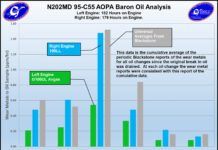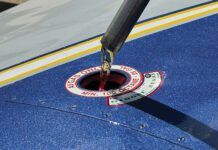Not to alarm you, but the highest price avgas in the U.S. recently topped $8, although the average hovers closer to the mid-5s. Long before this distressing development, a reader wrote with this suggestion: “You know, you really should look at the fuel economy of various airplanes. Im beginning to wonder if there’s a big enough mileage difference to make it worth looking at something else.”
Answer: We can, we have and there is. A certain class of owner-OK, the cheap screws-have always considered fuel efficiency above all else, either because they don’t have to carry much in the airplane or they don’t want or need to go fast. Of such stuff are Mooney owners made. (And we can prove it.)
Since it costs $250 to fill up a Cherokee, more owners than ever are dropping back to survival mode and asking what kind of capability 8 gallons an hour will buy. (More than you think, perhaps, but in any case better than padlocking the hangar door.)
Speed Kills…
…the fuel budget. What has always been true is still true: If you want to go fast, youre not going to do it on a miserly amount of fuel in a certified airplane. Conceding that fast is in the eye of the beholder, for our purposes “fast” is anything faster than 150 knots. Ignoring the FAAs definition of high performance, we think everyone can agree that 150-knots-plus is high performance.
Three decades ago-1975-oil cost $12 a barrel and avgas was about 45 cents a gallon, or about $1.87 adjusted for inflation in 2008 dollars. This means that the real cost of avgas has increased three fold, much of it during the past three years. In 1975, a Cessna 210L burned 13 to 15 gallons to cruise at 160 knots or faster. Thirty years later, the Centurion burns just as much as it ever did, which is roughly the equivalent of driving a 1975 Buick Electra (all two tons of it) in an age of $4 mogas. The 210, by the way, ranks in the lower third of our efficiency top 40 listed on page 25. Interestingly, the cutting edge models from Cirrus and Cessna/Columbia rank a little worse than a 30-year-old Centurion in an economy flyoff and, unfortunately, they carry a little less, too. But the newer airplanes are faster and if throttled back to super-economy power settings, they can deliver marginally better mileage than the older airframes. (B ut they still cant carry more.)
Asleep?
Have the GA manufacturers been asleep all these years while, during the equivalent period, the automotive industry has reinvented the economy car several times over? Not really. For one thing, aircraft gasoline engine technology is mature and although there are minor economy gains to be made, the big one has already been mined: the established trend of running lean of peak after tweaking the fuel distribution in fuel-injected engines. Second, until recently-three years or so-complaints about rising fuel prices has been a low-volume murmur. Buyers want four seats, comfortable cabins and useful loads of at least 900 pounds-1200 pounds if they can get it. Recent fuel price shocks may change that, but they havent yet. Cynics may complain that high avgas prices will wipe out GA flying, but there’s one stop on the way to extinction and thats more efficient airframes.
Diamond Sparkles
In this regard, only one company excels, but two other manufacturers hold their own. Our chart tells the tale. All of Diamonds aircraft are in the top 12, even the ill-starred diesel-powered DA40 Star. Surprisingly, right behind them are entry level Cessnas and-no surprise- a plethora of Mooney models.
Putting a sharp pencil on the cruise and fuel flow numbers, reveals some interesting but not surprising findings. The Diamond models have slicker airframes than the Cessnas and with roughly equivalent power, they go a little faster but burn a little less fuel and thats all it takes to make them efficiency leaders. The Cessnas are draggier, but go just fast enough burning a modest amount of fuel to make them kings of the economy middle ground.
Then there are the Mooneys, which have always had a reputation of being the fastest kids on the block. But the reality is that they often havent been. The popular 201 isn’t as fast as a Cessna 210 and the 231/252 struggles to keep pace with the turbocharged Centurion. What Mooneys always have been, however, is efficient at moderate to high speeds or more efficient yet at lower speeds. Interestingly, Mooney recently advanced that cause further by nipping some drag on its latest model, the Type S Acclaim. At its top cruising speed, the Acclaim is fast-242 knots-but not especially economical, at 11 MPG. But dialed back to 220 knots, its efficiency is 13.3 MPG, placing it right in the middle of the economy 40 (ok, 38), but at a speed no other piston aircraft approaches.
Give Ups
In any airplane, economy comes at a price and for the airplanes in the top 12, its either speed, lower payload, smaller cabin or all three. A Cirrus feels less cramped than a Mooney for a reason, but its larger frontal area creates more drag and saps efficiency by a couple of miles per gallon. The same applies to the Cessna/Columbia models. At 20 MPG, a Cessna 152 is admirably economical, but a sardine can for the occupants. With the Katana/Eclipse/Evolution, Diamond offers small drag and light weight, which yields a faster airplane thats also economical. The cabin is enough larger to give at least the illusion of more space. The Katanas are actually a little heavier than the Cessna 150/152 series, but the later models have fuel-efficient Continental IO-240 engines, which is why they occupy the top of the economy ziggurat.
We didnt list any twins in our chart because, frankly, the results are gruesome. For the perceived safety of an extra engine and higher useful load in something like a Cessna 310, the mileage drops to 8 MPG, best case. Worst case, its a lot worse.
The not-at-all-surprising overall economy winner is Diamonds Thielert diesel-powered DA40 Star. For the top spot, however, Diamond has paid a price that may threaten its very existence. In recent months, Thielert has undergone a financial meltdown and is now in bankruptcy, seeking investors. Diamond, meanwhile, is furiously developing its own diesel engine, the Austro, whose fuel specifics and power are supposed to be superior to the Thielert engine. If thats true, it could crunch the curves from both directions and provide better performance and greater economy.
What It Means
If, as our e-mail suggests, a segment of owners are seeking more fuel economical airplanes in lieu of giving up flying entirely, there are clearly choices available in the current fleet. Obviously, the owner of a Malibu wont want to step down to a Cessna 152 or a Diamond DA20, but a Cherokee owner might. Or a Bonanza driver who doesnt use the airplane for travel anymore.
Another bit of wisdom buried in our fuel economy chart is that even without trying, the industry has produced a handful of fuel-efficient airframes. And we arent talking about LSAs, either.
If avgas reaches $10-and maybe even if it doesnt-there’s an opportunity to build moderately fast certified airplanes that will deliver 40 MPG or better and that will be promoted primarily as being fuel efficient and less for their speed, payload, comfort or impressive avionics. We predict you’ll see these at Oshkosh within five years. You may even want to own one.




